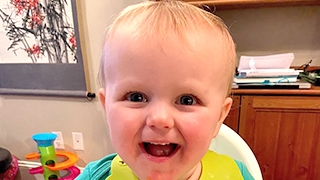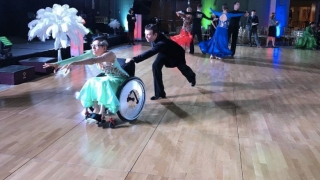GRIN1-Related Disorders
What are GRIN1-related disorders?
Pathogenic variants (“mutations”) in the GRIN1 gene cause a spectrum of neurodevelopmental disorders that can include childhood-onset epilepsy, developmental delays, movement disorders, and features of autism spectrum disorder. The symptoms a child experiences and the severity of the disorder can vary widely.
GRIN1 is not the name of a medical condition but rather is the name of the gene that is affected. When a disorder is traced back to a pathogenic variant in the GRIN1 gene, it is called a GRIN1-related disorder.
Signs and symptoms of GRIN1-related disorders
In many children, delays in achieving developmental milestones during infancy or early childhood may be the first indication of a GRIN1-related disorder. In other children, seizures are the first sign of the condition. In most individuals with GRIN1-related disorders, seizures begin in early childhood, usually around 2 years of age. However, the age of onset varies widely between individuals, ranging from shortly after birth to later in childhood. Some people with GRIN1-related disorders may never develop epilepsy.
All children with GRIN1-related disorders have some degree of developmental delay and cognitive impairment, which ranges in severity from mild to severe.
Epilepsy is a common feature of GRIN1-related disorders, and is present in approximately two-thirds of children with this condition. Children with GRIN1-related disorders may develop different types of seizures, which are often difficult to control with anti-seizure medications. Common seizure types may include:
- Infantile spasms
- Absence seizures
- Focal impaired awareness seizures (seizures where children stop their usual behavior and become unaware)
- Focal motor seizures (abnormal movements or jerking of one part of the body)
- Generalized tonic-clonic seizures, also called grand mal seizures (in which the body, arms and legs extend, then contract and shake)
Many children with GRIN1-related disorders also have:
- Decreased muscle tone (hypotonia) centrally (in their “core”)
- Increased muscle tone (spasticity) peripherally (in the limbs)
- Movement disorders, including dystonia and chorea
- Behavior disorders, including aggression, hyperactivity or features of autism spectrum disorder
- Cortical visual impairment
- Feeding difficulties
- Small head size (microcephaly)
- Developmental brain differences, such as polymicrogyria
Diagnosis of GRIN1-related disorders
Delays in reaching developmental milestones in infancy and early childhood combined with seizures is not specific but is consistent with a GRIN1-related disorder. However, there are no typical signs of a GRIN1-related disorder that enable a diagnosis based on clinical features alone.
Genetic testing is required to diagnose a GRIN1-related disorder.
Additional tests may also be done, including:
- Electroencephalogram (EEG) to look for evidence of abnormal brain activity and seizures
- Magnetic resonance imaging (MRI) to look for changes in brain structure. Although most children with GRIN1-related disorders do not have developmental or structural differences in their brains, approximately 20% of individuals with GRIN1-related disorders have extensive polymicrogyria.
Genetics of GRIN1-related disorders
All children with a GRIN1-related disorder have a pathogenic variant in the gene GRIN1, which encodes the instructions to make a protein in the brain that forms a subunit of the NMDA receptor. NMDA receptors are ion channels in the brain that are activated by the neurotransmitter glutamate and that are important for synaptic transmission, learning and memory. When glutamate binds to the NMDA receptor, this activates the ion channel allowing positively charged particles called ions to flow through the membrane of the neuron. The flow of ions through the NMDA receptor, of which GRIN1 is part, is critical to the proper function of neurons. Mutations in GRIN1 impair this process and lead to abnormal functioning of NMDA receptors, resulting in epilepsy and associated developmental differences.
In most children with GRIN1-related disorders, the pathogenic GRIN1 variant occurred spontaneously (de novo) and was not inherited from either parent. In rare cases, the pathogenic GRIN1 variant has been passed on from an asymptomatic parent due to parental mosaicism. Just like a mosaic piece of art, in which each tile is different, a mosaic parent has distinct cell types. Most cells of a mosaic parent do not carry the pathogenic GRIN1 variant. However, a small proportion of cells do carry the pathogenic GRIN1 variant in very low levels that may be difficult or impossible to detect. In these families where a parent is mosaic, the chance that future siblings may also have a GRIN1-related disorder may be as high as 50%.
In very rare cases, both parents are silent carriers of pathogenic GRIN1 variants, and the child with the GRIN1-related disorder has inherited a mutation in GRIN1 from both parents. This inheritance pattern is called autosomal recessive inheritance. In these cases, there are no health risks to individuals who are silent carriers, but the risk for future siblings to also have a GRIN1-related disorder is 25%.
Treatment for GRIN1-related disorders
Treatment for GRIN1-related disorders will depend on the type and severity of the seizures and associated neurological features.
- A combination of seizure medications is typically used to control the different seizure types. Epilepsy Neurogenetics Initiative (ENGIN) providers have experience in the management of epilepsy in children with GRIN1-related disorders and can guide optimal medication selection.
- A different set of medications, known as “rescue therapies,” may be given to help stop or shorten clusters of seizures when they occur.
- Implantable devices such as vagus nerve stimulation (VNS) or responsive neurostimulation (RNS) may be considered when medications are not effective in controlling seizures.
- Dietary therapy, such as the ketogenic diet, may be helpful in some cases.
Family training and support is a key element in a successful epilepsy treatment plan. Parents and caregivers must know how to watch for and respond to seizures.
Cognitive and developmental delays or autism spectrum disorder associated with GRIN1-related disorders are treated with physical, occupational and speech therapy, and with the support of early intervention services. Care may be provided by a developmental pediatrician.
Why choose CHOP for treatment of GRIN1-related seizure disorders?
Families come to our ENGIN Clinic from all over the world. Children with GRIN1-related disorders who are cared for at Children's Hospital of Philadelphia (CHOP) will receive cutting-edge genetic testing to confirm the underlying cause of their condition, as well as parental testing to confirm the diagnosis and inform recurrence risk with a subsequent pregnancy. Through ENGIN, your child will have access to any other medical specialists they may need. They will also have access to a full range of epilepsy therapies provided through CHOP’s Pediatric Epilepsy Program, including medication, dietary treatment and epilepsy surgery, cutting-edge research and clinical trials, and ongoing follow-up care.
All individuals seen in the ENGIN Clinic are offered the opportunity to participate in research studies related to GRIN1.
ENGIN integrates genetic testing into the diagnosis and treatment of children with difficult-to-treat or unexplained epilepsies, genetic epilepsy syndromes and other genetic neurodevelopmental disorders. We combine cutting-edge clinical care and advanced genetic testing with innovative research to identify the underlying cause of a child’s epilepsy and develop an individualized approach to treatment and management.
Resources for GRIN1-related disorders
CureGRIN Foundation
Simons SearchLight
Beyond the Ion Channel | Dr. Helbig’s Blog for The ILAE Genetics Commission
References
Delineating the GRIN1 phenotypic spectrum: A distinct genetic NMDA receptor encephalopathy. Lemke JR, Geider K, Helbig KL, Heyne HO, Schütz H, Hentschel J, Courage C, Depienne C, Nava C, Heron D, Møller RS, Hjalgrim H, Lal D, Neubauer BA, Nürnberg P, Thiele H, Kurlemann G, Arnold GL, Bhambhani V, Bartholdi D, Pedurupillay CR, Misceo D, Frengen E, Strømme P, Dlugos DJ, Doherty ES, Bijlsma EK, Ruivenkamp CA, Hoffer MJ, Goldstein A, Rajan DS, Narayanan V, Ramsey K, Belnap N, Schrauwen I, Richholt R, Koeleman BP, Sá J, Mendonça C, de Kovel CG, Weckhuysen S, Hardies K, De Jonghe P, De Meirleir L, Milh M, Badens C, Lebrun M, Busa T, Francannet C, Piton A, Riesch E, Biskup S, Vogt H, Dorn T, Helbig I, Michaud JL, Laube B, Syrbe S. Neurology. 2016;86(23):2171-2178.
De novo mutations in GRIN1 cause extensive bilateral polymicrogyria. Fry AE, Fawcett KA, Zelnik N, Yuan H, Thompson BAN, Shemer-Meiri L, Cushion TD, Mugalaasi H, Sims D, Stoodley N, Chung SK, Rees MI, Patel CV, Brueton LA, Layet V, Giuliano F, Kerr MP, Banne E, Meiner V, Lerman-Sagie T, Helbig KL, Kofman LH, Knight KM, Chen W, Kannan V, Hu C, Kusumoto H, Zhang J, Swanger SA, Shaulsky GH, Mirzaa GM, Muir AM, Mefford HC, Dobyns WB, Mackenzie AB, Mullins JGL, Lemke JR, Bahi-Buisson N, Traynelis SF, Iago HF, Pilz DT. Brain. 2018;141(3):698-712.


